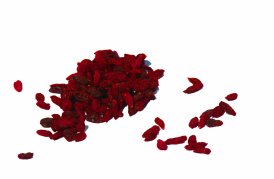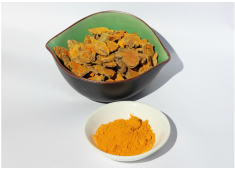Chinese Medicine in your Food
Most of us have used them in our everyday cooking, to add flavours or as whole foods themselves, but how many of you knew that what you’re adding to your meals is actually a herbal medicine?
Everyday herbs and spices have been used in Chinese Medicine for thousands of years to treat a wide range of health conditions.
Today we look at Black Sesame Seeds, Goji Berries and Honey.
For Ginger, Turmeric and Cinnamon simply scroll to the bottom.
Everyday herbs and spices have been used in Chinese Medicine for thousands of years to treat a wide range of health conditions.
Today we look at Black Sesame Seeds, Goji Berries and Honey.
For Ginger, Turmeric and Cinnamon simply scroll to the bottom.
Black Sesame Seeds - Hei Zhi Ma

crushed black sesame seeds pictured
Black Sesame Seeds are the seeds from the Sesamun indicum plant.
Sesame Seeds are used in many different cuisines for its rich nutty flavour. They can be used
whole on breads and buns, in salads and fried dishes.
Sesame oil is also derived from the seeds.
In Chinese Medicine, Black Sesame Seeds are used to tonify Yin Fluids and Blood. It strengthens the Liver and Kidneys, helps relieve rheumatism, constipation, dry coughs, low back pain, weak knees and stiff joints.
Sesame Seeds are used in many different cuisines for its rich nutty flavour. They can be used
whole on breads and buns, in salads and fried dishes.
Sesame oil is also derived from the seeds.
In Chinese Medicine, Black Sesame Seeds are used to tonify Yin Fluids and Blood. It strengthens the Liver and Kidneys, helps relieve rheumatism, constipation, dry coughs, low back pain, weak knees and stiff joints.
Goji Berry (Wolfberry) – Gou Qi Zi

Goji Berries are the fruit of two closely related species of plant – Lycium barbarum and Lycium chinense.
Goji berries have many culinary uses. They can be used in teas, added to soups and even used in wine making.
In Chinese Medicine, Goji berries tonify the Liver and Kidneys, nourish the blood, improve eyesight and ease back and leg aches.
Goji berries have many culinary uses. They can be used in teas, added to soups and even used in wine making.
In Chinese Medicine, Goji berries tonify the Liver and Kidneys, nourish the blood, improve eyesight and ease back and leg aches.
Honey – Feng Mi

Honey is a food made by bees. It is made from the nectar of flowers.
Honey has been used as a food for many thousands of years. It is used as a sweetener in teas and other beverages, as well as in cooking and baking, or as a spread.
In Chinese Medicine, Honey harmonizes the liver, is an anti-septic (neutralizes toxins) and an anti-inflammatory (relieves pain). Honey aids with constipation, stomach upsets, sinusitis and tension. It can also help to moisten dry sore throats as well as fight off the germs
Honey has been used as a food for many thousands of years. It is used as a sweetener in teas and other beverages, as well as in cooking and baking, or as a spread.
In Chinese Medicine, Honey harmonizes the liver, is an anti-septic (neutralizes toxins) and an anti-inflammatory (relieves pain). Honey aids with constipation, stomach upsets, sinusitis and tension. It can also help to moisten dry sore throats as well as fight off the germs
Ginger – Sheng Jiang

Ginger is the rhizome (rootstock) of the Zingiber officinale plant.
The culinary use of ginger is generally that of a spice. It can be used fresh or dried, as well as whole or powdered. It can also be used in teas as well as other beverages such as ginger beer.
In Chinese medicine, ginger acts on the lungs, spleen and stomach channels. It warms the stomach to help stop vomiting, nausea, morning sickness and menstrual cramps. Ginger also warms the lungs to help stop coughs and remove phlegm. It also helps with bronchitis, aches and spasms.
The culinary use of ginger is generally that of a spice. It can be used fresh or dried, as well as whole or powdered. It can also be used in teas as well as other beverages such as ginger beer.
In Chinese medicine, ginger acts on the lungs, spleen and stomach channels. It warms the stomach to help stop vomiting, nausea, morning sickness and menstrual cramps. Ginger also warms the lungs to help stop coughs and remove phlegm. It also helps with bronchitis, aches and spasms.
Turmeric – Jiang Huang

Turmeric is the rhizome (rootstock) of the Curcuma longa plant which is in the same family of plant as Ginger.
Turmeric is also generally used as spice in cooking, and known for its deep orange-yellow colour. It too can be used fresh or dried, and whole or powdered.
In Chinese Medicine, turmeric is known for its anti-inflammatory and anti-oxidant properties. It improves digestion of protein, helps reduce uterine tumours, decongests the liver, helps dissolve gallstones and also helps reduce menstrual pain.
Turmeric is also generally used as spice in cooking, and known for its deep orange-yellow colour. It too can be used fresh or dried, and whole or powdered.
In Chinese Medicine, turmeric is known for its anti-inflammatory and anti-oxidant properties. It improves digestion of protein, helps reduce uterine tumours, decongests the liver, helps dissolve gallstones and also helps reduce menstrual pain.
Cinnamon – Rou Gui and Gui Zhi

Cinnamon (Rou Gui) is the inner layer of bark of various species of tree of the Cinnamomum Genus. Gui Zhi is the cinnamon twig.
Cinnamon is used as a dry spice, whole or powdered.
In Chinese Medicine, Cinnamon tonifies the kidneys and warms the heart. It is used to eliminate chill, ease diarrhoea, improves circulation to warm cold hand and feet, eases lower back pain as well as provides energy.
Cinnamon is used as a dry spice, whole or powdered.
In Chinese Medicine, Cinnamon tonifies the kidneys and warms the heart. It is used to eliminate chill, ease diarrhoea, improves circulation to warm cold hand and feet, eases lower back pain as well as provides energy.
